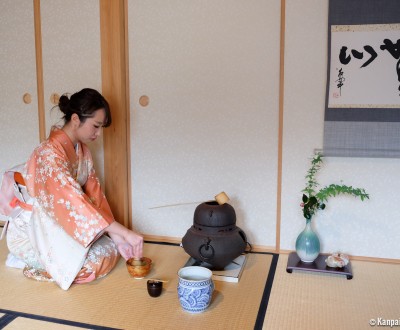Japanese tea ceremony
The traditional art of serving matcha tea
Imported from China in the 12th century, green tea powder, or matcha, is a favorite of the Japanese people. Adopted by Buddhist monks and then by samurai warriors, it is particularly popular during Sado, a traditional tea ceremony.
Origins
Created during the 16th century by Sen No Rikyu (1522-1591), the Japanese tea ceremony includes four main principles, which together form the expression 和敬清寂 wakeiseijaku:
- 和 wa : Harmony
- 敬 kei : Respect
- 清 sei : Purity
- 寂 jaku : Tranquility
Nowadays, the philosophy of this ceremony is taught in special schools. The ceremony master must be trained in other traditional arts, such as ikebana (flower arrangement), calligraphy, kimono 👘 wearing, ceramics, and incense. The teaching and practice of this ceremony lasts a lifetime, and masters forever remain apprentices of their sensei (teachers).
Until the end of the 19th century, the tea ceremony was only performed by men; it was the occasion when samurais plotted among themselves, away from battles. During the Meiji era, which marked the beginning of the end for these warriors, women took the lead in the ceremony and maintained its traditions through World War II. Even today, the custom favors women rather than men.
Utensils for matcha tea
In the most traditional version, the protocol is strongly codified and requires that each guest bring three objects:
The tea ceremony master also uses the following objects:
Tea house
Traditionally covered in a thatched roof, a Japanese tea house welcomes guests with a square door called a 躙り口 nijiriguchi, which is always 66 cm high and 63 cm wide. This specification is meant to make all the guests of the ceremony equal. Moreover, this relatively narrow entrance originally forced samurais to leave their katana (swords) outside.
The tea room is the size of four and a half tatami, or 7.5 m². The decorations include harmonious colors and materials, and they are modified for each ceremony. There is also an alcove that houses a kakemono (a hanging scroll of calligraphy), accompanied by a small floral arrangement called a chabana.
The tea ceremony
In the long version of the ceremony, the guests first have a light meal of kaiseki traditionnal japanese cuisine, called chakaiseki. Accompanied with sake 🍶, the meal ends with a Japanese pastry called a wagashi. In the short version, only the dessert is eaten.
There are two types of ceremonies: one with light tea and one with strong tea. Below is a description of the short version of the more popular type, in which light matcha is tasted.
- Purification. The tea master, who wears traditional clothing, starts by greeting the guests, then places the various utensils in their usual locations. The host uses a silk square (chakin) to wipe the tea box (natsume) and the spoon (chashaku). Then, the host washes the bowl (chawan) by stirring hot water with the whisk (chasen). The host controls the bamboo whisk carefully to protect its condition. The host then removes the water and dries the bowl with the fabric (chakin).
- Preparation. The master places two spoonfuls of matcha powder in the bowl, which is about two grams, and then adds water and mixes the preparation with the chasen. The mixing starts with a light twirl that unifies the drink. Then, the host uses a firm, quick motion: back and forth, up and down. As a result, the drink gains a smooth and foamy texture. The host then lays the chasen on the right side of the bowl; the chasen must hold tea foam to signify the right consistency in the preparation.
- Tasting. Now that the drink is ready, the host serves it to the most honored guest, presenting the bowl from the front side. Before tasting, the honored guest must greet the other guests. Then, the honored guest lifts the bowl in a sign of respect to the host and turns it twice clockwise, thus positioning the front side of the bowl opposite the mouth. Drinking from the front of the bowl is considered an unforgivable mistake. The tea must be drunk in a series of two and half sips, until finished, in order to show the master that the tasting is complete. Finally, the honored guest positions the bowl with the front side toward the host and puts it down gently.
- Thanks. The host thanks the first guest and takes the bowl back; at this time, the preparation for the second guest begins, following the same process. Once all the guests have finished their tea, the master proceeds to meticulously clean all the utensils, finally showing them, one by one, to each guest so that each person can admire their quality and beauty.
Attending a tea ceremony
The tea ceremony lasts from one to four hours, depending on the number of guests, the type of meal, and the type of tea being served.
Some tea houses allow visitors to book in advance in English (for example, Camellia Tea House in Kyoto), but others only allow visitors to show up at the house on the day of the ceremony, with no advance booking.

